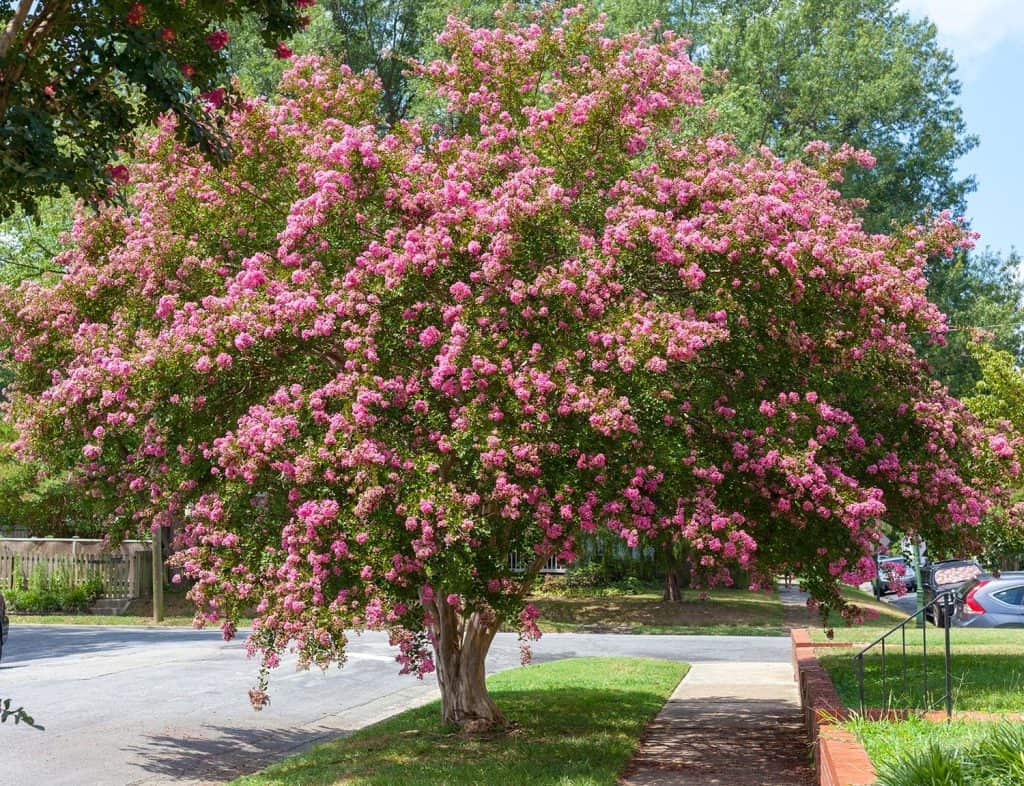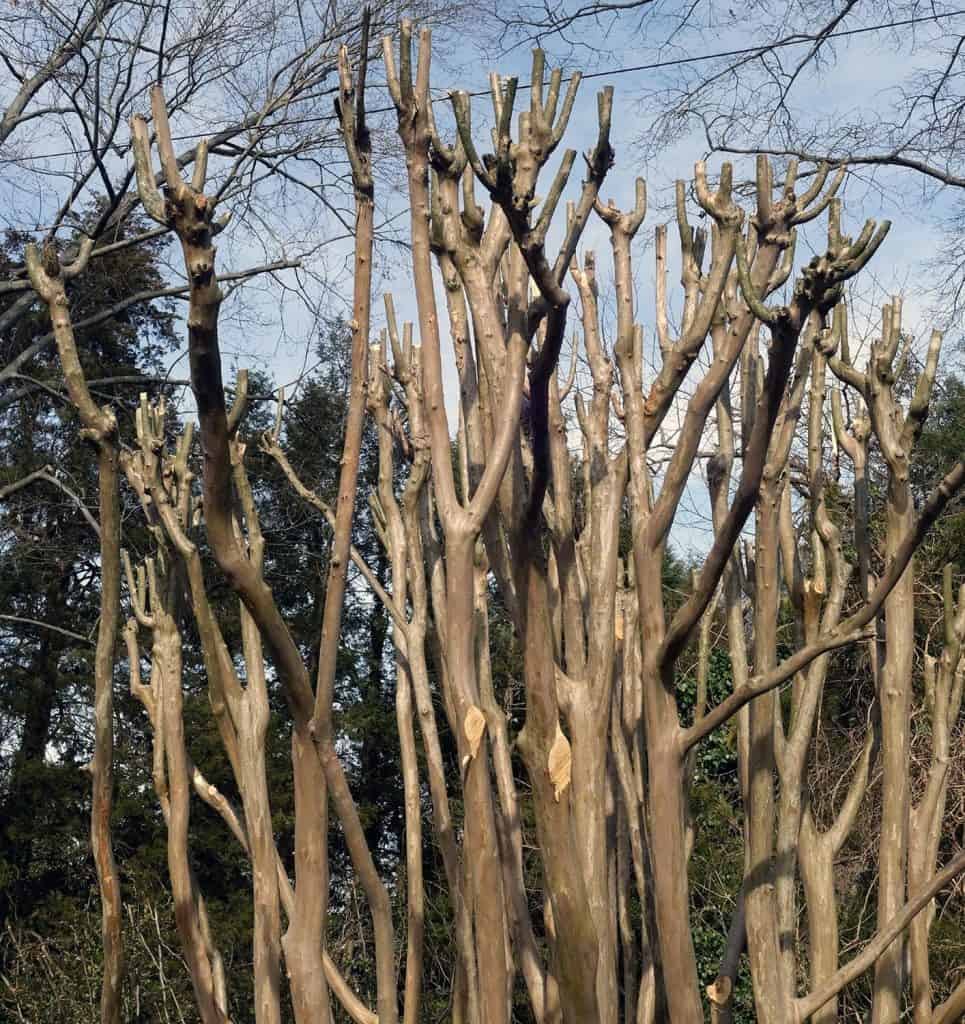Crepe myrtle trees are beautiful plants with colorful, delicate flowers. But if you're considering adding them to your landscaping, you may have some questions first. For example, how far do crepe myrtle roots spread, and how deep do they go? We've checked with arborists for everything you need to know about this eye-catching vegetation.
Crepe myrtle roots can spread over a wide area. They may cover two or three times further than the tree's diameter. However, the root system is rather shallow. It is not invasive and, as a result, not prone to causing much damage.
Keep reading, and we'll explain more about how crepe myrtle roots spread. We'll give you some tips for picking a location for your tree. We'll let you know what you don't want near your tree and what the root system means for nearby houses, pipes, sidewalks, and more. Further, we'll discuss how the crepe myrtle roots can be challenging and how to handle or prevent annoying growths like shoots and suckers.
![A reddish orange crepe myrtle trunk and roots in early spring, How Far Do Crepe Myrtle Roots Spread? [And How Deep]](https://gardentabs.com/wp-content/uploads/2022/02/How-Far-Do-Crepe-Myrtle-Roots-Spread-And-How-Deep-683x1024.png)
How Far Do Crepe Myrtle Roots Spread?
Crepe myrtle has an extensive network of roots. These roots can spread two or three times further than the canopy or surface area of the tree.
As a result, you won't want to place other plants or grasses too close by. They'll be forced to compete for water and other nutrients. These root systems tend to crowd out neighbors, and your other plants may not thrive.
Not sure how big your tree will get? Read How Big Does A Crepe Myrtle Get?
How Deep Are Crepe Myrtle Roots?
The roots of crepe myrtle trees have a broad reach. However, they aren't particularly deep. The root system is shallow and fibrous, primarily growing near the surface.
Do Crepe Myrtles Have Invasive Roots?
Crepe myrtle roots are shallow and active, but they are not invasive. The roots are unlikely to cause problems for concrete or bother sidewalks or driveways.

There's also little concern about the seeds being invasive or taking over your yard. Some trees reproduce readily from seeds, which would pose a problem. However, this is mostly unfounded.
Most of the popular crepe myrtle trees are hybrids. This means that most cultivars are unable to reproduce by seed. While certain types may be considered potentially invasive, this doesn't apply to the majority of crepe myrtle plants.
How Close Can A Crepe Myrtle Be Planted To A House?
Most crepe myrtles grow around 15-25 feet tall and 6-15 feet wide. This varies some between cultivars. Some trees grow as tall as 40 feet.
The roots pose no real threat to your home's foundation. But it's still important to leave adequate room for the plant to grow to its full size. The standard recommendation is to plant 8-10 feet away from walls.
Leaving some distance can also help prevent nuisance problems. For example, crepe myrtles offer beautiful flowers. But too close to the house, and you may find those flowers plugging up your gutters.
In addition, crepe myrtle does best in full sun. As a result, planting too close to the house may filter too much sunlight. Be sure to pick your location carefully, with this in mind.
For more tips on sunlight needs, read How Much Sun Does A Crepe Myrtle Need?

Can Crepe Myrtle Roots Damage Pipes?
Because of their non-invasive nature, crepe myrtle roots are one of the better choices as a "sewer-friendly" plant. While any root can potentially clog already damaged sewer lines, crepe myrtles are unlikely to do much damage.
A recommendation by Orange County Sanitation District lists crepe myrtles as one of the better options. The roots are shallow and fibrous, generally unable to overpower nearby pipes.
Want to learn about some other non-invasive trees you can enjoy? Try "15 Fruit Trees With Non-Invasive Roots"
How Do You Get Rid Of Crepe Myrtle Roots?
If you've cut down your crepe myrtle, you may find that the root system is somewhat zombie-like. It's tough to kill, as suckers keep popping back up in an attempt to revive the plant.
But have no fear, as you can still kiss this tree goodbye [forever!] The two options available are removing the roots or killing them with herbicide.
Manual Removal

While removing the roots manually is possible, this can be a problematic approach. The roots are shallow, so you won't have to dig very far.
However, it can be tough to know when you've gotten them all. And don't forget that the roots may spread as much as three times wider than the tree's surface area or branches.
When any roots are left behind, they'll continue to grow. This means that it may take several tries to dig up the entire system successfully. And you may dig the same area more than once, having to remove new roots if you didn't get it all the first time.
Also, be sure to dispose of the roots properly. Do not compost them or let them lay in the yard, as they may re-plant themselves.
Using Herbicide
Because manual removal can be tricky, many people elect to use herbicide instead. Spray a phenoxy herbicide directly on the leaves of the suckers. This can kill the roots while still avoiding harm to the nearby grass.
Click here to see this herbicide on Amazon.
Tordon is another effective herbicide. It is applied directly to the freshly cut stump. It then enters the tree's root system, which prevents new growth.
Click here to see Tordon on Amazon.
You can also try a plant growth regulator. Some examples are Sucker Stopper or Sucker Punch.
Click here to see Sucker Punch on Amazon.
Always be sure the follow the manufacturer's instructions and proper safety guidelines. When misused, the product may be ineffective or even hazardous.
How To Prevent Crepe Myrtle Suckers
What if you don't want to kill your crepe myrtle tree? Perhaps you enjoy having it as part of your landscape. But you don't care for the ring of suckers that always seems to be encircling the tree.
Unfortunately, there's no way to stop the suckers altogether. They're a natural part of the root system and will continue to co-exist with the tree. But with careful cultivation, you can keep them tamed.
- Make sure your plant gets full sun. With inadequate sunlight, sucker production increases. This is one method the plant uses to help it survive.
- Improve soil drainage. In wet soil, roots are stimulated for more sucker shoots.
- Prune the tree every spring. Prune early, when the tree is still dormant. Go light, as heavy pruning can lead to more sucker growth.
- Remove any suckers that come up immediately. Dig up the soil around the sucker, about an inch deep. Then cut off the sucker with garden loppers. Recover what's left of the sucker with the dirt, being careful not to leave the cut shoot exposed.

In Conclusion
While crepe myrtle trees have a far-reaching network of roots, they don't pose many concerns. The roots are shallow and non-invasive, so they don't create many problems. They won't interfere with nearby pipes, damage your home's foundation, or breakthrough sidewalks, driveways, or concrete.
However, the roots can take water or nutrients away from nearby plants or grasses. Be sure to give your crepe myrtle adequate space to grow and thrive without making other plants compete with the large and developed root system. Further, the roots do tend to branch out with suckers. Keep the plant healthy and pruned to minimize the growth and frequency of these shoots.
As long as the plant is given room to grow to its full size without any interference, there's no reason to expect any problems. Some basic maintenance is all that's required for a healthy tree. Once you've picked the right location, you can enjoy your beautiful crepe myrtle flowers for a long time with little hassle.




That last photo of the butchered crape myrtles needs a caption saying, “DON’T do this!”
I have suckers coming up and blooming in my flower bed. Can you remove them and replant them
Absolutely. Just be certain that the sucker is rooted on its own. If it is not, sever the root coming from the parent plant only, cover it back up with soil, keep it moist, and wait until it shows signs of new growth. Dig and pot for a few months before replanting. Good Luck!